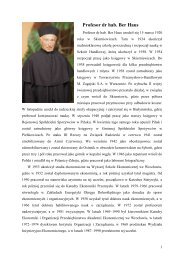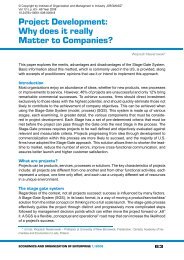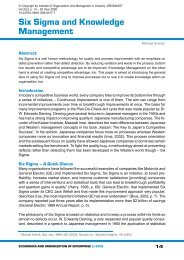Intellectual Capital Measurement Methods
Intellectual Capital Measurement Methods
Intellectual Capital Measurement Methods
You also want an ePaper? Increase the reach of your titles
YUMPU automatically turns print PDFs into web optimized ePapers that Google loves.
<strong>Intellectual</strong> <strong>Capital</strong> <strong>Measurement</strong> <strong>Methods</strong><br />
Value Chain<br />
Scoreboard<br />
Intangible<br />
Asset Monitor<br />
<strong>Intellectual</strong><br />
<strong>Capital</strong><br />
Navigator<br />
and <strong>Intellectual</strong><br />
<strong>Capital</strong><br />
Index<br />
(IC Index)<br />
Value Creation<br />
Index<br />
Lev<br />
(2002)<br />
Sveiby<br />
(1997)<br />
Roos<br />
and<br />
others<br />
(1997)<br />
Ittner<br />
and<br />
others<br />
(2000)<br />
A matrix of nonfinancial indicators arranged in<br />
three categories according to the cycle of development:<br />
Discovery, Learning, Implementation,<br />
Commercialization.<br />
Management selects indicators, based on the<br />
strategic objectives of the firm, to measure four<br />
aspects of creating value from intangible assets.<br />
By: 1) growth, 2) renewal, 3) utilization /<br />
efficiency; and 4) risk reduction / stability.<br />
The Intangible Assets Monitor consists on a formal<br />
presentation of several relevant indicators<br />
for measuring assets according to the company<br />
strategy. This indicators form the base to create<br />
and develop a company with knowledge focused<br />
strategy. It can be integrated in the management<br />
information systems. The object is to<br />
represent the intangible assets from different<br />
perspectives: growth and renewal, efficiency<br />
and stability.<br />
<strong>Intellectual</strong> capital is broken down into 3 areas:<br />
human, relational and organizational plus the<br />
conventional physical and monetary resources.<br />
These are all subdivided. Several user-friendly<br />
plots are produced including a navigator, a conceptual<br />
diagram of how the company works in<br />
IC terms. Indices are defined based on the key<br />
resources and resource transformations in the<br />
navigator.<br />
The purpose of the method is to help managers<br />
to visualize growth by measuring the <strong>Intellectual</strong><br />
<strong>Capital</strong>.<br />
For the creators of the method, the importance<br />
of the specific measures varies from one company<br />
to another. They suggest four high level<br />
categories as the foundation for discussion in<br />
individual cases. The develop of measures within<br />
these categories is formed by a three stage<br />
process:<br />
1. A critical review of existing indicators<br />
2. Development of indicators that represent the<br />
flows between different <strong>Intellectual</strong> <strong>Capital</strong> categories<br />
3. Develop a hierarchy of <strong>Intellectual</strong> <strong>Capital</strong><br />
indices<br />
All the indices have to be aggregated into a single<br />
index that can be used to make comparison<br />
over time of the same unit or even compare with<br />
other business units. The critical factor for the successful<br />
application of the method is the process of<br />
creation of the <strong>Intellectual</strong> <strong>Capital</strong> Services, and<br />
this is the point in which the experience of the <strong>Intellectual</strong><br />
<strong>Capital</strong> Services lies, the assistance to<br />
the companies to create their own ICIndex.<br />
Drivers of value are derived from an extensive<br />
literature survey and advanced statistics. Metrics<br />
are weighted and combined to give a Value<br />
Creation Index. The index is compared and<br />
combined with financial data.<br />
disadvantages are that the<br />
indicators are contextual<br />
and the meanings of the resource<br />
definitions can vary<br />
between each organization<br />
and each purpose, which<br />
makes comparisons very<br />
difficult. They cannot be<br />
connected easily to financial<br />
results.<br />
ECONOMICS AND ORGANIZATION OF ENTERPRISE 1/2008<br />
43







